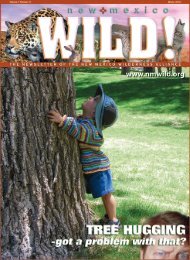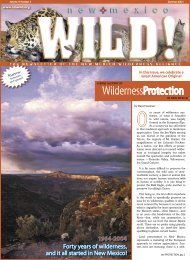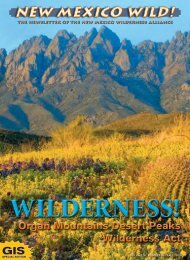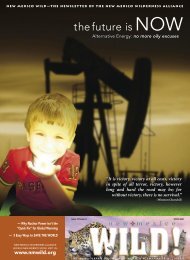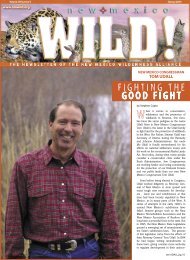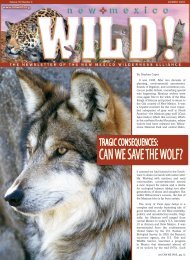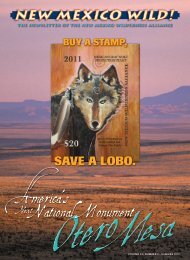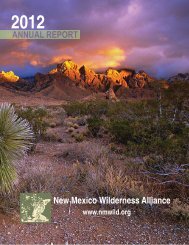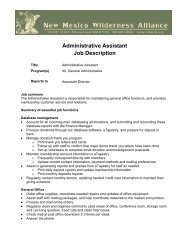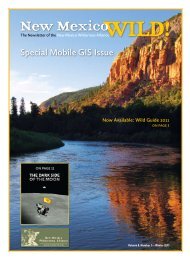THE NEWSLETTER OF THE NEW MEXICO
THE NEWSLETTER OF THE NEW MEXICO
THE NEWSLETTER OF THE NEW MEXICO
- No tags were found...
You also want an ePaper? Increase the reach of your titles
YUMPU automatically turns print PDFs into web optimized ePapers that Google loves.
New Mexico WILD!<strong>THE</strong> <strong><strong>NEW</strong>SLETTER</strong> <strong>OF</strong> <strong>THE</strong> <strong>NEW</strong> <strong>MEXICO</strong> WILDERNESS ALLIANCEVOLUME X, NUMBER II— SUMMER 2008Building CommunityFor a Stronger New MexicoNew Mexico WILD!Page 1
the expansion of Bed and Breakfasts inSilver City or outfitters in the Pecos.These are exciting times, and I thinkall of us at New Mexico WildernessAlliance take seriously our roleand responsibility to the communitiesacross New Mexico. Buildingcommunity speaks to building trust,understanding the people that callQuesta home, or the lone rancher inthe West Potrillos. In the end, we sharethe common goal of making the landbetter and our communities stronger.SabinosoWilderness BillPasses the HouseWashington, D.C.—On June 9, the Sabinoso Wilderness Act of 2008 (H.R.2632) passed out of the House of Representatives. If passed by the Senate,this will be the second wilderness bill in New Mexico to be created in the lastthree years. Prior to the Ojito Wilderness Bill of 2005 there had been no newWilderness created in almost 20 years.Introduced in 2007 by Congressman Tom Udall (D-NM), the SabinosoWilderness Act seeks to designate the majestic canyons and rugged beauty ofone of the finest intact Great-Plains ecosystems left in New Mexico. Just 40 mileswest of Las Vegas, New Mexico, the Sabinoso Wilderness Study Area encom-We simply believe that wilderness isa tool that has tremendous power tomake people, wildlife and landscapesstronger and more secure. To that endwe will keep fighting, listening andworking together for the communitieswe all call home.Bill Would Create2nd WildernessArea in NewMexico in the LastThree Yearspasses approximately 20,000-acres ofpublic land and is home to a varietyof wildlife, including the Americankestrel, savannah sparrow, red-tailedhawk, broad tailed hummingbird,coyote, mountain lions, mule deerand gray foxes.“New Mexico’s varied wildlandsenhance our quality of life and create apowerful incentive for attracting newbusinesses to our state by creating thekind of environment where peoplewant to live, work and enjoy freetime with their families,” said NathanNewcomer, Media Director with theNew Mexico Wilderness Alliance.“Wilderness is a cornerstone of ourheritage.”The Sabinoso Wilderness Act is widelysupported by local governments,business and economic developmentinterests, sportsmen, conservationgroups, and state officials. Morespecifically, the New Mexico StateHouse of Representatives, San MiguelCounty Commission, Village ofWagon Mound, and the Town ofSpringer have passed resolutionssupporting the designation of theSabinoso Wilderness.Main Office505/843-8696 • fax 505/843-8697nmwa@nmwild.org • www.nmwild.orgP.O. Box 25464, Albuquerque, NM 87125Las Cruces Field Office275 N. Downtown MallLas Cruces, NM 88001505/527-9962Santa Fe Field Office341 E Alameda StSanta Fe, NM 87501505/216-9719Taos Field Office108B Civic Plaza DrIveTaos, NM 87571505/751-7309Mission StatementThe New Mexico Wilderness Alliance isdedicated to the protection, restoration,and continued enjoyment of New Mexico’swildlands and Wilderness areas.NMWA StaffAlbuquerque OfficeStephen Capra, Executive DirectorTripp Killin, Associate DirectorNathan Newcomer, Grassroots OrganizerTisha Broska, Membership CoordinatorRoxanne Pacheco, Finance ManagerMichael Scialdone, Director of Wilderness ProtectionTrisha London, Membership & Grassroots AssistantCraig Chapman, Special Events CoordinatorCarlsbad OfficeSteve West, Southeast DirectorLas Cruces OfficeJeff Steinborn, Southern DirectorNathan Small, Wilderness Protection CoordinatorSanta Fe OfficeDavid Ehrman, Outreach CoordinatorTaos OfficeJohn Olivas, Northern DirectorBoard of DirectorsWes Leonard, Albuquerque, NM (Chair)Dave Parsons, Albuquerque, NM (Treasurer)Randy Gray (Vice Chair), Lake Valley, NMChristianne Hinks, Albuquerque, NMNancy Morton, Albuquerque, NMTom Mouck, Albuquerque, NMNancy Murray, Albuquerque, NMTodd Schulke, Silver City, NMBob Tafanelli, Las Cruces, NMRick Wiedenmann, Carlsbad, NMNewsletter StaffTisha Broska, Managing EditorJoe Adair, Design EditorJames Broska, Copy EditorWhat is Wilderness?The Wilderness Act of 1964established the NationalWilderness Preservation Systemto preserve the last remainingwildlands in America. TheWilderness Act, as federal policy,secures “an enduring resourceof wilderness” for the people.Wilderness is defined as an areathat has primarily been affectedby the forces of nature with theimprint of humans substantiallyunnoticeable. It is an area thatoffers outstanding opportunityfor solitude or a primitive orunconfined type of recreation,and an area that containsecological, geological, or otherfeatures of scientific, educational,scenic, or historical value.Please visit us atnmWILD.orgNew Mexico WILD!Page 3
Langsenkamp Legacy Lives on in Wilderness EducationBob Langsenkamp was a dedicated publicservant, life-long conservationist anddevoted New Mexican. He encouraged hischildren, his friends and his community: tolearn, explore, think, grow and laugh.An enthusiastic river runner, hiker,snow-shoer and cross-country skier,Langsenkamp explored many of thestate’s little-known nooks and crannieson boat, bicycle and foot, and was knownfor humorous stories and photos of theseadventures. After coming to Santa Fe fromSilver City, where he had roamed the GilaWilderness and much of the southern partof the state, he continued to discover out-ofthe-waytreasures in the North,taking family and friends along.As a key organizer and activistduring the 1982 elections,Langsenkamp had both a directand indirect role in boosting thepolitical careers of US SenatorJeff Bingaman, State LandCommissioner Jim Baca and BillRichardson. Hired to the LandOffice by Commissioner Jim Baca,Langsenkamp worked there for14 years, retiring in 1996 fromhis position as Deputy Commissioner.He served as an active elderstatesman and conciliator withinan often-contentious environmentalcommunity, and was widelyrespected for his evenhandedness,integrity and commitment. He wasamong the few able to combine astrong understanding of ecologicalprinciples and conditions on-thegroundwith an understanding of thepolitical process. As a result, his counselwas respected and sought by leading NewMexico officeholders, including Senator JeffBingaman, Representative Tom Udall, LandCommissioners Jim Baca and Ray Powell,and numerous state legislators.He played a key role in New Mexico’s landconservationand Wilderness protectionmovements for more than two decades. Hewas, for instance, a founder of the New MexicoConservation Voters Alliance (CVA) in 1982and the New Mexico Wilderness Alliance in1997, and an active member of the SierraClub. Before he died he had been involvedwith efforts to support a next generation ofleaders, both at NMWA and CVA.Today, we are very proud to carry on Bob’svision with the Bob Langsenkamp Fundfor the New Mexico Wilderness Alliance.Bob left us with a legacy of goodwill,dedication and selfless devotion to theprotection of our natural world. With thegenerous gift of $100,000 by Bob’s widow,Sally Strong, the New Mexico WildernessAlliance will continue this devotion.The fund is designed to support NewMexico Wilderness Alliance’s efforts toeducate the community - communityleaders, our congressional delegation,activists, editorial page editors and thegeneral public about the value and importanceof Wilderness. NMWA will engageour youth in wilderness activities.The integration of these programs will occurover a period of three years and will explainthe value and importance of wilderness forcommunities and individuals across our state.Please join us in this important campaignto make Wilderness a long-term investmentby making a generous contribution today toThe Bob Langsenkamp Fund for the NewMexico Wilderness Alliance. Our address is:The New MexicoWilderness Alliance,PO Box 25464, Albuquerque, NM 87125.Bob Langsenkamp, born October 4, 1946,died in St. Vincent’s hospital on March1, 2002. To the shock and dismay of hisfriends and family, Wilderness hero BobLangsenkamp suffered a brain aneurysm.Bob was a devoted husband and father oftwo children.Wilderness EducationNew Mexico Wilderness Alliance will begin Wilderness Education Program for thestudents of the Mora and Questa Independent School District this fall. The BobLangsenkamp Fund for the New Mexico Wilderness Alliance will help us educateyoung people, grades 7-9, about the value of wild landscapes and wildlife in order todevelop a new generation of wilderness and wildlife advocates. This will be a 3 yearprogram that will be implemented within each of the school districts later this fall.A Visit into the Past, Looking to the FutureEthel Hess, Publisher,New Mexico MagazineI’m embarrassed to admit it! I’ve lived inSanta Fe since September 1981 and myfirst visit to Chaco Canyon was on May 22,2008. I don’t know why it took me morethan 26 years but I do know what got methere. The thought of Chaco Canyon being“infiltrated” by oil exploration and thepotential dangers to the Historical Parkwere abhorrent to me. I needed to see andlearn as much as I could.The weather on the day of our visit wasextremely wet – I hesitate to say it washorrible, because we need the rain so badly– and very windy. Luckily, I had “followedinstructions” and brought a rain parka andsome warm layers along.We spent a fair amount of time withDeputy Superintendent Russ Bodnar andRanger J.B. Cornucopia in the warmth ofa conference room in the Visitors’ Centerlearning some of the park history andsome of the modern day challenges facingthe park. It was evident that both men hadpassionate feelings about the park and itsfuture.Two of the imminent dangers to the parkare the developmentof existingoil leases thatare contiguousto the park andthe potentialupgrading of theroad leading intothe park.The argument forroad improvementis that it couldenhance the economic lives of the residentsalong its way. Among the argumentsagainst is that it could bring much moretraffic to the park than it can handle. Ourtour of Pueblo Bonito made the fragilityof the ruins painfully obvious. Although,the park rangers are welcoming totourists, there is neither enough staffingnor adequate infrastructure to handlethe potential numbers to which visitationmight swell.The danger of oil exploration is thepotential damage to the ruins from seismicactivity that may occur.Why should Chaco Canyon be moreprotected from more visitors and from oilexploration? The value of Chaco Canyonis in its history and what we can learnfrom it. History teaches not only about thepast, but it leads us to revelations aboutour present and our future. I am told that“upping” the designation of Chaco Canyonto Wilderness will help protect it. I believethat and wholeheartedly support that!I want to thank David Ehrman and the NewMexico Wilderness Alliance for waking meup to Chaco Canyon and giving me theopportunity to share some of my thoughts.New Mexico WILD!Page 5
discover NewMexiconew mexico’snorthern expanseBy John Olivas, Northern Director of NewMexico Wilderness AllianceNew Mexico is an area of great beautyand resilience, particularly the northernportion of the state. From snow cappedpeaks sitting at over 13,000 feet near Taosto the high plateaus rising above 7,000 feetin Santa Fe, northern New Mexico offerssome fascinating landscapes.The Pecos Wilderness, Latir PeakWilderness and Wheeler Peak Wildernessare located in the Santa Fe and CarsonNational Forests. These areas are withina few hours drive from Santa Fe andAlbuquerque and offer a wide variety ofoutdoor recreational activities includinghiking, fishing, camping and huntingopportunities.In addition to these Wilderness areasin northern New Mexico, there are alsoproposed wilderness areas that include ElRio Grande National Conservation Area(NCA), Kiowa National Grasslands and theSabinoso. Each of these areas possessestheir own persona and uniqueness.El Rio Grande Del Norte NationalConservation Area (NCA) ProposalA portion of the Rio Grande River flowsthrough a sizeable gorge otherwise knownas the infamous Rio Grande Gorge. Fromthe Colorado border, the first 50 milesof the Rio Grande is a National Wild andScenic River, the first area in the US to bedesignated in 1968. In this area the RioGrande cuts through remote, volcanic land- a flat lava plateau dotted with the blackcones of long extinct volcanoes, generallydeserted and undeveloped. Most of thearea is accessible only by unpaved tracksthat run along the canyon rims on eitherside of the gorge. The deepest part of thegorge, west of Questa, is part of the Bureauof Land Management-Wild Rivers RecreationArea (WRRA). In the WRRA a pavedroad runs alongside the Rio Grande for 7miles and ends at the Wild Rivers VisitorCenter at the confluence of the Red Riverand the Rio Grande. This area is known tothe locals as La Junta Point. The Red Riverflows westwards from the Sangre de CristoMountains to La Junta Point, joining theRio Grande 800 feet below the plateau.El Rio Grande del Norte National ConservationArea (NCA) proposal of 303,000acres, including proposed wildernessareas on Ute and San Antonio Mountainsnorth of Taos, New Mexico also encompassthree land grant communities: the SanAntonio de Rio Colorado Land Grant,Sangre de Cristo Land Grant and the Casade Guadalupe Land Grant. For severalgenerations, the land grant communitieshave utilized the proposed NCA forgrazing, firewood and pinon gathering andoutdoor recreational activities. One sitewithin Wild Rivers is Sheeps Crossing, anarea traditional used by land grant heirswho have crossed sheep and cattle forover a century. This is the only crossingwithin the Rio Grande Gorge for ranchersof Questa to cross cattle without having totrailer their livestock.The three land grants are looking to capitalizeon the economic benefit of the proposedNCA if and when it becomes designated.Collaborative efforts with the environmentalcommunity on these efforts havealready begun. The staff of the New MexicoWilderness Alliance is currently workingwith the community of Questa to assist incapturing economic dollars as a result of theproposed wilderness designation.The Proposed El Rio Grande Del NorteNational Conservation Area is managedby the Bureau of Land Management-TaosField Office 226 Cruz Alta Road Taos,New Mexico 87571-5983. Phone (575)758-8851 (575) 758-1620 FAX.Accessing Wild Rivers Recreation Area:Wild Rivers Recreation Area can beaccessed through Taos on Highway 522three miles north of Questa. From NM522 take NM 378 west, through the villageof Cerro and into open land towards thegorge that encompasses the Wild RiversVisitor Center. The 13-mile road crosses alevel plain, which enters first into SheepsCrossing and then to the gorge.Kiowa National GrasslandsThe Kiowa National Grasslands are partof a national grasslands system in northeasternNew Mexico that includes the RitaBlanca, McClellan Creek and Black Kettle.These four grasslands are administeredfor the U.S. Department of Agriculture bythe Cibola National Forest and cover over263,000 acres scattered throughout NewMexico, Texas and Oklahoma.The Kiowa National Grassland just northof Roy, New Mexico includes 12 miles ofthe Canadian River Canyon above theConchas Reservoir. The Canadian RiverPotential Wilderness located within theKiowa National Grasslands area is approximately6,033 acres and encompasses partof the Mills Canyon.As people entered the grasslands in the mid1800’s, the Homestead Act of 1862 allowedfor settlers to pour into the Mills area. Thegrasslands provided a promise of a betterlife for agriculture crops and the grazing oflivestock. Within time, the dust bowl eraof the 1930’s proved to be overwhelmingand many of the settlers were forced tomove out of the area. Remnants of oldhomesteads still exist today and can beeseen in and around the Kiowa NationalGrasslands.In addition, the grasslands provide foragefor livestock and wildlife and provideprotection to important watersheds.Protecting this pristine ecosystem shouldbe the priority of all who embrace itsbeauty. The Kiowa National Grasslands aremanaged by the Cibola National Forest:2113 Osuna Road, NE, Suite A, Albuquerque,NM 87113. Phone (505) 346-3900Accessing the Kiowa National Grasslands:Take I-25 north approximately 40 milespassed Las Vegas to Wagon Mound. FromWagon Mound head east 45 miles onHighway 120 to the town of Roy. From Roymake a left and head north on Highway39 approximately 8 miles to Mills. InMills take Forest Road 600 that extendsfrom Mills above the canyon to the MillsCanyon Campground. The Forest Servicehas developed camp and picnic grounds inMills Canyon that are open for public use.SabinosoOn June 9, the Sabinoso Wilderness Act of2008 (H.R. 2632) passed out of the Houseof Representatives. If passed by the Senate,this will be the second wilderness bill inNew Mexico to be created in the last threeyears. Prior to the Ojito Wilderness Bill of2005 there had been no new Wildernesscreated in almost 20 years.Sabinoso is located 40 miles east of Las Vegasoff Highway 65 in north central New Mexico.Sabinoso is a pristine landscape with longmesas engulfed by Canon Largo with densestands of pinyon-juniper. With elevationsranging from 4,500 – 6100 feet, the areaencompasses many cliff dwellings. Althoughno official archeological surveys have beenconducted, the area has rich history thatdates back to the Paleo-Indian era.Currently there is no public access to theProposed Sabinoso Area. The only way toaccess the area is to make arrangementswith the Bureau of Land Management,Taos Field Office. The Taos Field Office ismaking efforts to purchase private landswithin the proposed designation, whichwould provide a right-of-way to gainpublic access to the area.To access the area you can contact theBureau of Land Management, Taos FieldOffice 226 Cruz Alta Road Taos, NewMexico 87571-5983. Phone (575) 758-8851(575) 758-1620 FAX.New Mexico WILD!Page 11
How to Endanger a SpeciesBy Steve WestFor many, one of the great sights on OteroMesa is the small, scattered towns ofblack-tailed prairie dogs. Once numberingin the hundreds of millions, the specieshas suffered a 95% decline and is nowextirpated from Arizona. Currently foundfrom southern Canada to northern Mexico,the species occurs generally in small andscattered populations.The Otero Mesa area has more than a dozentowns, but now may have less. Our staffand volunteers have found a decrease in theactivity at the towns in recent months. Onecolony west of Alamo Mountain has notshown any prairie dog activity in monthsand rumors are that it was poisoned.Another colony north of Alamo showedlittle activity on a recent visit.A group of students and teachers fromCarlsbad visited these two towns as partof a science summer program. Again,nothing was found at the first. At thesecond town only a single young prairiedog was seen running from burrowto burrow and finally entering one. Itseemed odd that the young prairie dogwould be out alone at that time of day andalso that it was going to several differentburrow entrances. The students investigatedfurther to find out why. Numerousburrows were filled in with dirt and mixedin with the dirt were broken beer bottles.Further examination also uncoveredmany spent rifle shells (and at least onelive round).It is obvious what is happening. Someoneor more likely, several people, have takenit upon themselves to kill off the fewremaining prairie dogs on the mesa.Sadly, this is not illegal but it is wrong onmany other levels.Over 170 other vertebrate species dependon prairie dogs to one degree or another,either as a source of food, or using theburrows and the landscape that prairiedogs modify. But most important, prairiedogs have a right to live and this is beingviolated with guns, beer bottles andprobably poison. While many rancherswould hate to see the species listed asendangered by the US Fish and WildlifeService, others have taken it uponthemselves to kill the species in there area,in case that happens. Listing the speciesas endangered or threatened mightrestrict some ranching activities. Someare being proactive and destroying prairiedog towns before that happens, and as aresult, greatly increasing the chances for itto be listed as endangered.The Bureau of Land Management (BLM)which manages much of this land needsto take action. Bill Childress is the newmanager of the Las Cruces office andshould be contacted on this issue. He canbe reached by mail at:Bill Childress, District ManagerBureau of Land ManagementLas Cruces District Office1800 Marquess StreetLas Cruces, NM 88005-3370Or by phone at: (575) 525-4300Or by email at: bill_childress@nm.blm.govNew Mexico WILD!Page 17
NO TEACHER LEFT BEHINDGeorge Bush’s controversial No ChildLeft Behind is panned by almost anyonewho knows a thing about it. ManySenators and Representatives voted forit, fully believing it was the best thingto move American kids forward. Evencritics however, admit that for the mostpart, most of the people pushing forthe program were pushing for it forthe right reasons. Whether ultimatelyit fails or not, many people bet theirlives and reputations on it because theyhonestly believed it was what publiceducation needed.But what about the oil and gas programof “leave no teacher behind?” Theprogram is called the Center for EnergyEducation and is run inArtesia, and sponsored byYates Petroleum Corporationand Mack EnergyCorporation. Yates/Mack has run this summerschool for a numberof years designed forteachers in New Mexicoto come to Artesia, spenda week and learn aboutthe energy business. Well,the oil and gas businessanyway. The programthat they developed wasbased on a similar (andmore balanced) one runfrom the Colorado Schoolof Mines in Golden,Colorado.The plan is to inviteteachers to apply and thenaccept about 50 of themfrom around the state butmostly from the east andsoutheast. The teachers were paid $100per day to attend the classes whichwere made up of classroom lecturesand a one-day field trip. At the end ofthe class they were required to preparea lesson plan regarding oil and gasthat could be used in their classroom.Experts on various aspects of the oiland gas industry from exploration toprocessing and delivery are broughtin to “educate” the classroom teachersand hope that they would then takethat knowledge back to the classroomor at the very least, have a better understandingof the industry. Except that isnot exactly the whole story and perhapsnot the intended plan.There was of course, no discussion ofalternate energy except to talk abouthow it wouldn’t work—the technologywasn’t there, it would be moreexpensive, etc. Environmental concernswere also pooh-poohed. There is noglobal warming, no destruction of therainforest, etc.. And the environmentalistswho were pushing for clean air,oil and gas restrictions, and betterhealth for people? Well, these peoplewere just trouble-makers who eitherhad a hidden agenda behind all theirtrouble-making ways or were just abunch of idiots with too much timeon their hands. Otero Mesa? Teacherswere asked who had been there. Noone raised their hand. Then a photowas shown of dry grassland of OteroMesa and people were asked who reallythought the area was really worthsaving. Knowing only the oil and gasside of the issue and being shown aphoto of dry grassland, it is doubtfulmany people there would think OteroMesa was worth bothering about.Sadly, some of the teachers came withthe same ideas that Yates/Mack wastrying to foist on them and agreed withwhatever drivel was put out. Otherswho knew the other side were made tofeel very uncomfortable and kept quiet.This was not the setting for a frankdiscussion of the issues at an attemptto really deal with the energy problemsthat America faces. There was such acavalier attitude toward the truth onenergy issues and a real discussionof the pros and cons, that even thosewho had serious disagreements (andthere were some of those) did notfeel comfortable raising the questionswhich needed to be asked.Facts were continually misrepresented.Oil and gas were touted as a type ofrenewable energy which, depending onhow you look at it, they are. Teacherswere told that the process that makespetroleum deposits continues daily andtherefore it is renewable just like solarand wind. In fact, the process wouldtake hundreds of thousands, millionsof year to make new deposits of oiland gas. That minor fact was left out.Teachers who are teaching the youth ofNew Mexico, many of whom had a verylimited background in science, left theworkshop thinking that there wouldalways be oil and gas resources.So what does Yates/Mack get out of all ofthis? From their standpoint hopefullya bunch of teachers who will go back tothe classroom and spout off the same“facts” to impressionable students.A pamphlet from the IndependentPetroleum Association of New Mexicowas touted as a great summary of theissue. The problem with all this is notthat Yates/Mack is presenting the side ofthe oil and gas industry. The problemis that the negative side of oil and gaswas glossed over and the downsides ofalternate energy sources were extremelyhyped. The pamphlet, New MexicoOil and Gas Facts provides numerousexamples.An example of how problems withoil and gas are glossed over dealtwith water contamination. A longdiscussion was provided about sourcesof natural contamination and minimalmention of what the industry has doneto aquifers. They evenstate “Oil and naturalgas producers havegrown accustomed tooccasionally taking blamefor damage not of theirdoing.” While societywill need a mosaic ofenergy sources, readingthe pamphlet one wouldthink that the only choicewould by hydrocarbons.We face perhaps thebiggest challenge in thehistory of civilization intrying to continue havingadequate energy supplies.Over the years we havebecome dependent on oiland gas. Even oilman andPresident George W. Bushhas said we are “addictedto oil.” Hard decisions aregoing to have to be madeand this nation and othersare going to have to devote resources todeveloping alternate energy forms as wecannot drill our way to energy independence.Our current plan only makes usmore dependent. But industry, in thiscase Yates and Mack, are only adding tothe problem by presenting a programthat doesn’t tell all the sides, ignoresaccepted facts and views this opportunityas a way to propagandize andnot educate. And in the process, thismakes our nation and our wild placesever more vulnerable.Page 18 Summer 2008
Products, Services and Ideas for aHealthy & Sustainable LifestyleSolar InspirationBy Jean EisenhowerSOLAROVENI’ve used a solar oven now for two decades, and there was one year of my life whena solar oven was the only real way I had to cook my food. I could have used myfireplace, but even in the winter, the fireplace wasn’t nearly as easy.I’m back in the city now, but when I moved to the country in 1994 and began usingmy solar oven every day, I realized I loved to go outside to turn the oven. I worked atmy computer all day and watched nature through my windows, and if it weren’t forthat oven, the habits of a lifetime could have kept that window between nature andme. But solar cooking saved me. It “forced” me outside, and so I went.First, I noticed the clouds. Were they moving this way and might slow down mycooking? Or would they pass me by? And look at that raven flying with the hawks!I noticed the heat, I noticed the wind - powerful where I was on the western bajada ofthe Chiricahua Mountains. Time to set a chair beside the oven so a dust devil doesn’ttry to tip it over. The vultures are rising this morning. And phoebes are making theirnests again in the eaves. The day, the sunshine feels wonderful. So different fromstanding before a stove!The solar oven forced me to take regular small breaks in my workday – something I’dknown for years I needed to do, had been counseled about, but just couldn’t do. MyGerman work ethic was too strong to allow such “decadent” behavior. What hundredsof dollars of therapy couldn’t accomplish, my solar oven did: it attracted me withits practicality, then drew me outside so the day could whisper its seductions: Isn’tthe sunshine lovely on the skin? Wouldn’t it be nice to sit for a spell in the sun andclose your eyes? Just a moment…. And I did. Then I returned to my work, peaceful,satisfied, knowing that life is good, Nature cares for us, and I’m even learning how tocare for myself a little better.They cook! They save money! Food never burns, and it often tastes better. And theovens inspire us to quietly sit for precious moments in the sun.Jean Eisenhower puts on free solar oven workshops around New Mexico about once amonth. Her website is www.SolarInspiration.net.SWEET POTATO DESSERTEasy dessert sweet potato (for one or two): one medium sweet potato – sliced, 2-3 dates– chopped, and a few pecans, all tossed together and drizzled with light oil. Place all incovered cookware appropriate for either campfire or solar oven. Bake/stew until potato issoft. Enjoy!Jean EisenhowerWild Recipes WantedPlease send us your favorite backpacking or camping recipes to be considered forthe 2009 Wild Guide.Email recipes to Craig@NMWild.orgDEADLINE: August 15, 2008Solar Inspiration!Cook anything easily with the sun - temperatures up to 400 degrees! Only 22 pounds– great for home use or car camping. Reflectors fold flat for easy carrying. Oven tiltswhile cook pots stay level inside! Only $255 (shipping included!) for lifetime use.www.SolarInspiration.netProfits support third world alternatives to deforestationContact Jean Eisenhower, PO Box 1873, Silver City, NM 88062 575-534-0123NM State Park EventsRockhound Music in the Park - Saturday, July 19, 06:00 PM - 08:00 PMCome and kick up your heels to some great entertainment sponsored by the Friends of RockhoundState Park. Bring your lawn chairs and join us in the fun. Popcorn and light beverages are for sale at asmall price.Fees: No Entrance FeeContact: Visitor Center (575)546-6182Living Desert Full Moon Walk - Saturday, August 16, 07:45 PM - 08:15 PMAlthough the entrance time is limited to a half-hour, visitors stroll through the zoo by the light of the fullmoon. This is a beautiful time to experience the park.Fees: Regular Entrance FeeContact: Kathryn Jones (575) 887-5516Bottomless Bubble Fest - Saturday, August 30-Monday, September 1 08:00 AM - 05:00 PMBottomless LakeThis event is designed for and around scuba divers and their families. Activities include: a “dive poker”contest, underwater games, snorkeling, swimming, beach volleyball, nature hikes, Ranger talks andmore. Reservations for camping are recommended.Fees: Regular Entrance FeeContact: Steve Patterson 575-624-6058New Mexico WILD!Page 19
Great News:Southwesterners Are Wild About Wolves!New Mexico and Arizona residentsoverwhelmingly support havingMexican gray wolves back in thewilds of their state, with 69 percentof New Mexico respondents and77 percent of Arizona respondentssupporting the reintroduction ofMexican gray wolves into theirpublic lands, according to a new pollreleased on June 16. The poll wascommissioned by 19 conservationand wildlife organizations, includingthe New Mexico WildernessAlliance.The poll, conducted by Researchand Polling, Inc., reveals importantvalues behind support for the wolfreintroduction program. Peoplethink wolves are beautiful, wildanimals. When asked to choosebetween two statements, 64 percentof NM respondents and 76 percentof AZ respondents chose “the wolfis a benefit to the West and helpsmaintain a balance of nature,”compared to 11 percent in NMand 13 percent in AZ who optedfor “the wolf kills too many elk,UNMWild!On April 23, the Senate of the Associated Students of the University of NewMexico passed a resolution, drafted by UNM Wilderness Alliance, thataffirms the importance of the school’s adopted mascot, the lobo.This event represents another step in UNM Wilderness Alliance’s missionto build a long-delinquent coalition of support for its mascot. Any students,staff, faculty, or alumni who would like to help in this effort, please contactunmwild@unm.edu.It is not too late to recognize the values of courage and leadership thatthe wild lobo has represented for almost ninety years in the history andheritage of New Mexico.--Phil CarterPresident, UNM Wilderness Alliancedeer and livestock anddoes more harm thangood.”Mexican wolvesroamed the Southwest 80%freely until a federal70%predator-controlprogram wiped them 60%out about 80 years ago.50%Mexican wolves weregiven protection under 40%the Endangered Species30%Act in 1976, and theirreturn to their wild 20%homeland began with10%the release of threefamily groups of lobos 0%in 1998. Wildlife biologistsset a goal of atleast 100 wolves, whichthey predicted wouldinclude 18 breeding pairs, by 2006.The removal and killing of wolvesthat come into conflict with livestockhas resulted in a population declinein three of the last four years. Asof the latest population survey, inearly 2008, only 52 wolves and threePage 20 Summer 2008Do you generally support or oppose the reintroduction of the Mexican gray wolf into these public lands inArizona and New Mexico?90%69%32%37%Total Sample (n=507)21%9%12%breeding pairs were alive in thewilds of the Southwest. Wildlifebiologists and conservationistshave urged the U.S. Fish andWildlife Service to change the wayit manages wolves to better prioritizewolf recovery.The poll shows that the publicalso supports the recommendedchanges. Southwest voters favormore protection for wolves underthe Endangered Species Act; theythink the government shoulddo what it takes to keep wolvesalive versus the current focuson killing and removing wolvesthat prey on livestock; they thinkranchers should be responsible forremoving or rendering inediblecattle that die of non-wolf causeson public lands so wolves are notattracted to nearby live cattle; andthey support providing fundsto compensate willing publiclands grazing permittees for thepermanent retirement of publicgrazing allotments in high conflictareas on public lands. There area number of ways to solve thisproblem, but continuing thestatus quo, with a focus on killingand removing wolves, is not anoption.Clearly, it is important for agencydecision-makers and electedofficials to understand the viewsof voters in New Mexico andArizona. A copy of the survey isavailable at www.rpinc.com. A10%Support Oppose Don't Know/Won't SayStrongly Somewhat Don't Know/Won't Saybeautiful and instructive slideshowabout Mexican gray wolves isat http://www.azcentral.com/commphotos/azcentral/6151/1/18.Please send a copy of the poll, ora few words about the poll, witha personal letter expressing yoursupport for wolves, to one or all ofthe following:Congressman Tom Udall1410 Longworth House Office BuildingWashington, D.C. 20215http://www.tomudall.house.govSenator Jeff Bingaman703 Hart Senate Office BuildingWashington, DC 20510senator_bingaman@bingaman.senate.govTom Arvas, ChairmanNew Mexico Game and Fish Commission7905 Spain, NEAlbuquerque, New Mexico 87109New Mexico Game and FishCommissioners - Allhttp://www.wildlife.state.nm.us/commission/index.htmDr. Benjamin TuggleSouthwest Regional DirectorU.S. Fish & Wildlife ServiceP.O. Box 1306, Albuquerque, NM 87103-1306RDTuggle@fws.gov
“So much knowledge as to survival skills and awareness/wilderness training that I neverwant to miss a class. And they are a lot of fun!” MA -- New MexicoThis highly practical and empowering training is a synergy derivedfrom profound ancient skills and the best of modern methodology.It is based on decades of real-world experience out in the field in ruggedwilderness areas and intense international arenas, and also draws uponprofessional Medical Qigong and Chinese/Western herbology studies.People from various walks of life express much enthusiastic feedback aboutthe cutting-edge awareness and wilderness thrival workshops, and even highlyexperienced wilderness explorers and martial artists have been amazed at howmuch they have learned through personalized instruction:“I have a lifetime of immersion with Nature, and years of studies with the InnerTechnologies of Huna, energy work with Qigong, and Wilderness Awareness Teachingswith Tom Brown Jr. But this year I had the opportunity to enter the wilderness andexperience some real Magic.” DG --CAWatch for the two Workshops at the New Mexico Wilderness AllianceAnnual Conference in October: Basic Energetics of Wilderness Awarenessand Solar, Celestial and Energetic Navigational Skills. These will introduceyou to unique practical tools leading to increased sightings of wildlife, enhancedsafety, and a deeper level of Fusion with all that is around you. For furtherinformation about life-empowering training now available in your area visitwww.primalqisynergy.comToll-free 866-302-7517Katerina BabicEco-Broker - Red Door Realtydirect: (505) 620-8788main office: (505) 345-2108fax: (505) 343-1072katbabic@mac.comSpecializing in earth-friendly,people-friendly living spaces.greennm.orgCOME IN AND EXPERIENCE <strong>THE</strong>“EVERYDAY TREAT”WINE CELLAR NOW OPEN!!Graphic Design for Progressive Causesand for Political Campaigns.Joe Adair 505-319-3754Joe@JoeAdair.comPage 22 Summer 2008
You canmakeWildernessa part ofyour legacytoo.“I included New MexicoWilderness Alliance in my EstatePlan because I feel a responsibilityto Wilderness. Young people shouldenjoy the same places that havetouched my life.”- Bob HowardTo find out how, contact David Ehrman(505) 216-9719 or david@nmwild.orgfrom Tripp KillinWhile some people don’t like long good-byes,I’m not a fan of good-byes in general. That’sone of the reasons that, even though I’mleaving my position as Associate Director ofthe New Mexico Wilderness Alliance in July,I won’t be saying goodbye.It’s been four years since I came on board tomanage the fund-raising for the Alliance. Inthat time I’ve been amazed by our growth:in our membership, in our financial stability& reporting, and, most importantly, in oureffectiveness.And we’ve been incredibly effective! TheOjito Wilderness in 2005, the Valle Vidalin 2006, the historic opportunities in Taosand Doña Ana Counties that ramped up in2007, and the Sabinoso Wilderness passingthe U.S. House of Representativesjust last week (to name just a few).I doubt any conservation groupcould boast a more comprehensiveor consistent record.While I’d love to take credit forall this, it is our campaign staff,our board, and critically, ourmembership that make thesesuccesses possible.We are now one of the largeststate-based wilderness organizationsin the West. With over 5,400members we are a powerful forcefor protecting the wild places of ourspectacular state. From Carlsbad toAztec and from Silver City to Raton,people are engaged and involved inprotecting the wild public lands thatSee You Soonbelong to us all. From outside the state, it’sbeen my honor to write thank you notes tosupporters in California, Texas, Washington(both the state and DC), Illinois, Floridaand Oklahoma, all of who love New Mexicodeeply, even if it is not their current home.And this is why, even though I will nolonger be an employee, I won’t say goodbye.The New Mexico Wilderness Alliance willalways hold a special place in my heart, andI’ll remain a dedicated member, volunteerand donor.The New Mexico Wilderness Alliance is anamazing organization. It is a wonderfulgroup of staff, board and membershipwho have come together to save the best,forever.Who could say goodbye to that?Join New Mexico Wilderness Alliance Today! You’ll not only helppreserve New Mexico’s Wild Places for your own enjoyment… butyou’ll help ensure that future generations may enjoy them too.YES! I want to be a member of the New Mexico Wilderness Alliance!!! My contribution will gotowards the continued protection and wilderness designation of New Mexico’s natural heritage.$25 – Individual $100 – Contributing Other $__________$30 – Family $500 – Lifetime THIS IS A GIFT MEMBERSHIP FROM ____________________$50 – Supporting $10 – Student/SeniorName __________________________________________ Phone____________________________Street _______________________________________ E-mail_______________________________City, State, Zip ______________________________________________________________________New Mexico WILD!Mail yourTax DeductibleDonations to:New MexicoWilderness AlliancePO Box 25464Albuquerque, NM87125-0464Questions?505/843-8696Page 23
ALBUQUERQUE <strong>NEW</strong> <strong>MEXICO</strong> 87125October 112008 New MexicoTheWilderness Conference9am to 4pm hotel albuquerque old townPhoto: Cheryl Himmelsteinterry tempest williamscitizen writer, naturalistmary beathauthor, illustrator,naturalistlinda rundellBLM state directorREGISTER ONLINE WWW.NMWILD.ORGor call 505-843-8696limited space available • early birD registration $45 • includes lunchWILDERNESS WORKSHOPS: Creative Nature Writing by MaryBeath; Basic Energetics of Wilderness Awareness by RobertBawol; Birds of New Mexico by Roberta Salazar; Solar,Celestial and Energetic Navigational Skills by Robert Bawol;Building Community: Land Grants & Acequias and more.Questa VecindadChamber of CommercePO Box 1054, Questa, New Mexico 87556chamber@questavecindad.org • 575-586-9100questavecindad.orgCome to the Grand Opening of NMWA’s Conservation LibraryMonday, August 18th 8:30am at our Albuquerque office Enjoy free wi-fi, coffee, tea, andmorning snacks. The library and conference room will be remain open daily to our members(except Tuesday mornings) for free coffee and wi-fi.WILD FILM!New MexicoWilderness AllianceP.O. Box 25464Albuquerque, NM 87125Do you need to renew? Check yourmembership expiration date locatedabove your name and address.NONPR<strong>OF</strong>IT ORG.U.S. POSTAGEPAIDPERMIT NO. 426A Film Festival – Spectacular Award-Winning Wildlife FilmsA Benefit for Rivers & Birds ~ Teaching The Next Generation of Earth StewardsAlbuquerque: October ~ 24 & 25, 7pm at the KIMO <strong>THE</strong>ATERSanta Fe: in October ~ for details contact 505.699.4466 or go to riversandbirds.orgTickets per evening ~ $15/adult, $5/youth or $25 both evenings per adult.KIMO tickets, call Ticketmaster: 883-7800Film schedule ~ http://www.riversandbirds.org • photo by: Geraint SmithPage 24 Summer 2008



